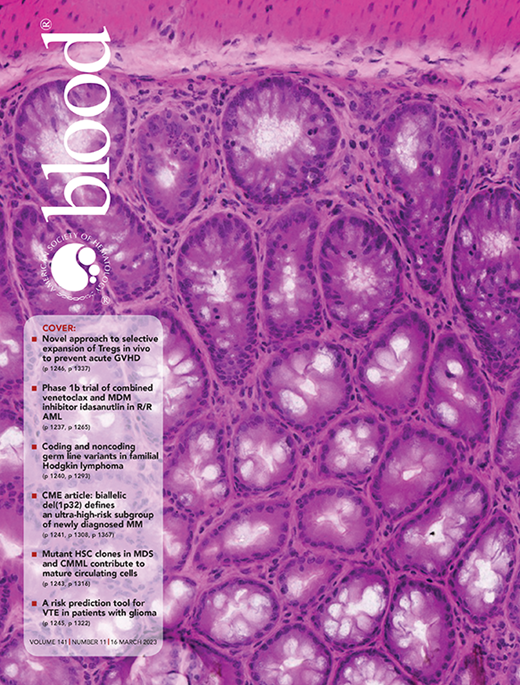In this issue of Blood, Burdett and colleagues describe the first venous thromboembolism (VTE) prediction model following surgical resection of grade 2 to 4, molecularly defined, adult-type diffuse gliomas.1
About 10% to 30% of patients with glioma experience a VTE event over the course of their disease.2 The majority of VTEs in glioma arise in association with surgical resection or while receiving adjuvant therapy.3 Advanced age, large tumor size, leg paresis, prior VTE, A or AB blood type, and the presence of intratumoral thrombosis have all been identified as thrombotic risk factors.4 The proposed mechanisms of thrombogenesis in glioma center on tumor production of tissue factor, procoagulant tumor microvesicles (MVs), and podoplanin, a transmembrane sialoglycoprotein believed to increase platelet activation in glioma.5 Gliomas with mutated IDH1 status have lower levels of tissue factor expression and may be associated with a lower risk of VTE than gliomas with wild-type IDH1—an observation first reported in 2016 by the authors of the present study.6 Podoplanin production by glioma cells is also downregulated in the presence of mutated IDH1.7
Despite the strong association of glioma with VTE, no VTE prediction tools are available that accurately gauge VTE risk in this disease. The Khorana score, the most widely used clinical prediction tool for VTE in cancer, did not include sufficient numbers of patients with glioma in its original study design, although modifications to the Khorana score to incorporate glioma have been devised.8,9 In the absence of accurate VTE prediction tools in glioma, the potential utility of prophylactic anticoagulation in these patients is uncertain, as concerns about hemorrhagic risks from anticoagulation have long dissuaded most practitioners from its use in patients with glioma despite their high VTE risk.3,10
In the current prospective, observational study, Burdett and colleagues have developed the first risk prediction model of incident VTE in glioma by analyzing 3 separate cohorts of patients with glioma: a discovery cohort of 393 patients with newly diagnosed or recurrent glioma treated at Northwestern Memorial Hospital in Chicago and 2 validation cohorts from Duke University (157 patients) and UCLA (68 patients). Using their discovery cohort, the authors employed lasso regression to identify 10 risk factors for incident VTE in patients with glioma in their initial discovery cohort. The identified risk factors, in no specific order, included: (1) IDH mutation status, (2) MGMT promoter methylation, (3) glioma grade, (4) prior history of VTE, (5) hypothyroidism, (6) asthma, (7) hypertension, (8) leukocyte count, (9) body mass index, and (10) patient age. These risk factors then in turn informed their Cox proportional hazards model with the continuous outcome of time-to-incident-VTE diagnosis, in the context of a mean follow-up period of 20.5 months across all cohorts. The model was then utilized to evaluate predictive ability for the outcome of interest in the 2 external cohorts. In all, the areas under the receiver operating characteristic curves for each external cohort, aiming to find an ideal balance of the highest specificity and sensitivity, were 0.79 to 0.84 in the discovery cohort and 0.63 to 0.68 and 0.70 to 0.73 in the 2 external cohorts. This is a respectable output in the context of clinical medicine (by comparison, this statistic was 0.7 for the Khorana score as originally reported in 2008). The model is available as an R Shiny application at https://kbellburdett.shinyapps.io/GliomaPredictVTE/.
In addition to the VTE prediction model, the authors also report a number of interesting pathophysiologic insights on VTE development in glioma. In their analysis, patients with wild-type IDH1/IDH2 showed a trend toward higher levels of circulating tissue factor on tumor MV (TF-MV). Patients with the highest levels of TF-MV activity had the fastest time to VTE and highest cumulative incidence of VTE. Tumor podoplanin had a significant association with development of VTE while circulating podoplanin did not. In a murine inferior vena cava stenosis model of thrombosis, mice with wild-type IDH1 and high tissue factor expression developed larger thrombi than mice with mutated IDH1 and low tissue factor expression.
In all, the new established model by Burdett and colleagues, and the pathophysiologic insights they report, represent major steps forward in the field of cancer-associated thrombosis and in the study of patients with glioma. As has been the case with nearly every VTE risk prediction model, future modifications of Burdett’s model may be expected by centers across the globe. In particular, a reevaluation of the model in the context of a competing risk framework might improve its performance, as patients without VTE in the current model were censored at last follow-up, inclusive of a possibility of having died; this would constitute a competing risk preventing full capture of VTE events that theoretically may have otherwise developed. Another consideration in interpreting the study findings is that only VTE events that occurred either after surgical resection for newly diagnosed glioma or prior to surgical resection of recurrent glioma were included in the analysis, which could in principle represent 2 distinct clinical scenarios for the development of VTE.
How might these findings be translated into clinical practice? One application could be the targeted use of prophylactic anticoagulation specifically in patients with a high VTE risk score calculation and IDH1/IDH2 wild-type disease, which might in principle offset some of the hemorrhagic risk from anticoagulation by selecting for patients predicted to have high levels of circulating tissue factor. Mechanistically, the impact of IDH mutation status on podoplanin production, differences in the potential roles of tumor-derived versus circulating podoplanin, and the effects of these variables on circulating TF-MV all raise exciting new questions about the pathophysiology of VTE in glioma, as well as the greater context of cancer-associated thrombosis. Through the incorporation of state-of-the-art clinical, pathologic, and molecular data, the incident VTE risk prediction model created by Burdett and colleagues represents a landmark advance with tremendous potential to transform the clinical care of patients with adult-type diffuse gliomas.
Conflict-of-interest disclosure: The authors declare no competing financial interests.

